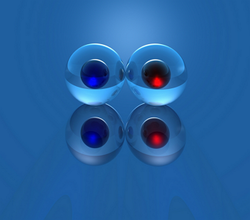Have you really lost your marbles?
 I have four boxes, each containing a number of red marbles and blue marbles.
I have four boxes, each containing a number of red marbles and blue marbles.
| Box A | Box B | Box C | Box D | |
If the probability of randomly selecting a red marble from Box A is , and the probability of randomly selecting a red marble from Box B is , then .
Suppose we group all the marbles in Box A and Box C into another Box AC; likewise we group all the the marbles in Box B and Box D into another Box BD. Now, there is a higher probability of randomly selecting a red marble from Box AC than from Box BD.
What is the sum of the smallest and the largest possible values of for which the above criteria is satisfied?
Image Credit: Flickr Lyle .
The answer is 32.
This section requires Javascript.
You are seeing this because something didn't load right. We suggest you, (a) try
refreshing the page, (b) enabling javascript if it is disabled on your browser and,
finally, (c)
loading the
non-javascript version of this page
. We're sorry about the hassle.
The probability of selecting a red marble from box A is 7 0 / ( 7 0 + 3 0 ) . Likewise, the probability of selecting a red marble from box B is y / ( y + 3 ) . So we have 7 0 / ( 7 0 + 3 0 ) < y / ( y + 3 ) , or y > 7 . So the lower bound of y is 8 .
The probability of selecting a red marble from box AC is ( 7 0 + 2 ) / ( 7 0 + 2 + 3 0 + 9 8 ) . Likewise, the probability of selecting a red marble from box BD is ( y + 7 ) / ( y + 7 + 3 + 5 3 ) . Since box AC's probability is higher, we have ( 7 0 + 2 ) / ( 7 0 + 2 + 3 0 + 9 8 ) > ( y + 7 ) / ( y + 7 + 3 + 5 3 ) , or y < 2 4 . 5 . Note that all the numbers are positive ( y is positive and we are only doing additions, so we can do the cross-multiplication very safely without changing the sign of the inequality). So the upper bound of y is 2 4 .
Hence 2 4 + 8 = 3 2 .